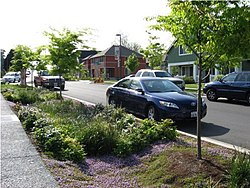living plants and natural materials within developed areas. Can be incorporated with gray infrastructure (utilities. paved surfaces. and buildings) to perform important ecological functions. such as stonnwater management. erosion control. temperature buffering. and more.
Green infrastructure or blue-green infrastructure refers to a network that provides the “ingredients” for solving urban and climatic challenges by building with nature. The main components of this approach include stormwater management, climate adaptation, the reduction of heat stress, increasing biodiversity, food production, better air quality, sustainable energy production, clean water, and healthy soils, as well as more anthropocentric functions, such as increased quality of life through recreation and the provision of shade and shelter in and around towns and cities. Green infrastructure also serves to provide an ecological framework for social, economic, and environmental health of the surroundings. More recently scholars and activists have also called for green infrastructure that promotes social inclusion and equality rather than reinforcing pre-existing structures of unequal access to nature-based services.

Green infrastructure is considered a subset of "Sustainable and Resilient Infrastructure", which is defined in standards such as SuRe, the Standard for Sustainable and Resilient Infrastructure. However, green infrastructure can also mean "low-carbon infrastructure" such as renewable energy infrastructure and public transportation systems (See "low-carbon infrastructure"). Blue-green infrastructure can also be a component of "sustainable drainage systems" or "sustainable urban drainage systems" (SuDS or SUDS) designed to manage water quantity and quality, while providing improvements to biodiversity and amenity.
